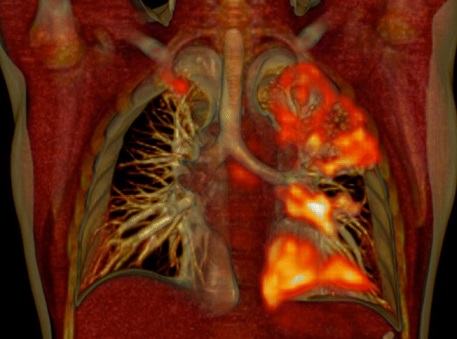Nikhil Prasad Fact checked by:Thailand Medical News Team Jun 29, 2024 1 year, 5 months, 3 weeks, 4 days, 1 hour, 32 minutes ago
Medical Innovations: Tuberculosis (TB) remains one of the deadliest infectious diseases worldwide, second only to COVID-19. In 2021 alone, 10.6 million people fell ill with TB, and 1.6 million died. Diagnosing and monitoring TB has always been challenging, but a new advancement in medical imaging offers hope for more effective treatment. Researchers from the UK and the US have developed a specific PET scan using a novel radiotracer that promises to revolutionize TB detection and treatment. This
Medical Innovations news report covers this novel approach to a more accurate TB diagnosis.
 New PET-Scan Breakthrough for Accurate TB Detection
The New PET Scan for TB
New PET-Scan Breakthrough for Accurate TB Detection
The New PET Scan for TB
A team from the Rosalind Franklin Institute, the Universities of Oxford and Pittsburgh, and the National Institutes of Health in the U.S. has created a new radiotracer called FDT. Radiotracers are radioactive compounds that emit radiation detectable by scanners, creating detailed 3D images of the body. The innovation with FDT lies in its specificity: it is absorbed only by live TB bacteria in the body, allowing doctors to pinpoint the exact location and activity of the disease in the lungs.
Current Diagnosis Methods and Their Limitations
Currently, TB diagnosis relies on two primary methods: spit tests and PET scans using the radiotracer FDG. Spit tests detect TB bacteria in a patient’s saliva but can often show negative results even when the disease is still active in the lungs, potentially leading to premature treatment cessation. On the other hand, FDG-based PET scans detect inflammation in the lungs. However, inflammation can result from various conditions, not just TB, leading to potential misdiagnosis. Moreover, inflammation can linger even after TB bacteria are eradicated, causing unnecessarily prolonged treatments.
What is FDT And Its Advantages
FDT (2-[18F]fluoro-2-deoxy-trehalose) is the new radiotracer developed to improve TB detection. It combines a sugar molecule called trehalose, which is specifically absorbed by TB bacteria, with a radioactive isotope, fluorine-18, commonly used in medical imaging. This unique combination allows FDT to target only TB bacteria in the body, making it possible to create precise 3D images with PET scans. The process of making FDT from FDG is simple and doesn't require specialized labs, making it accessible even in low-resource settings. This advancement promises more accurate TB diagnoses and better treatment monitoring, especially in regions heavily affected by the disease.
FDT specifically targets TB bacteria, offering several advantages over existing methods:
-Accuracy: It accurately identifies live TB bacteria, ensuring that treatment is neither prematurely ended nor unnecessarily extended.
-Simplicity and Accessibility: The production of FDT from FDG is straightforward and does not require specialized laboratories. This makes it accessible even in low- and middle-income co
untries where TB is most prevalent.
-Compatibility: FDT can be used with standard PET scanners, which are increasingly available worldwide, making it a viable option globally.
Significance for Global Health
TB remains a significant health challenge, particularly in developing countries that account for over 80% of TB cases and deaths. The ability to accurately diagnose and monitor TB in these regions is crucial. In 2022, 1.3 million people died from TB, highlighting the urgent need for improved diagnostic tools. The new PET scan with FDT can be a game-changer, potentially reducing the global TB burden by ensuring accurate and timely treatment.
Research and Development
The development of FDT involved extensive pre-clinical trials to ensure its safety and effectiveness. These trials showed no adverse effects, and the radiotracer is now ready for Phase I human trials. Professor Ben Davis, who led the research, emphasized the importance of accurately identifying active TB for both initial diagnosis and ongoing treatment. Dr. Clifton Barry III from the U.S. National Institute of Allergy and Infectious Diseases highlighted FDT’s potential to monitor treatment efficacy in real-time, which could significantly enhance clinical trials for new TB drugs.
Conclusion
The new PET scan using FDT marks a significant advancement in TB diagnosis and treatment. By providing a more accurate and accessible method to detect active TB bacteria, this innovation has the potential to save millions of lives, particularly in the hardest-hit regions. As FDT moves into human trials, there is hope that this breakthrough will soon be available in health care systems worldwide, offering a much-needed tool in the fight against TB.
The study findings were published in the peer reviewed journal: Nature Communications.
https://www.nature.com/articles/s41467-024-48691-6
For the latest on
Medical Innovations, keep on logging to Thailand Medical News.
Read Also:
https://www.thailandmedical.news/news/south-korean-researchers-warn-that-tuberculosis-increases-risk-of-various-cancers
https://www.thailandmedical.news/news/medical-thailand-thai-study-validates-that-covid-19-induced-immune-dysfunction-is-driving-increased-incidence-of-pulmonary-tuberculosis
